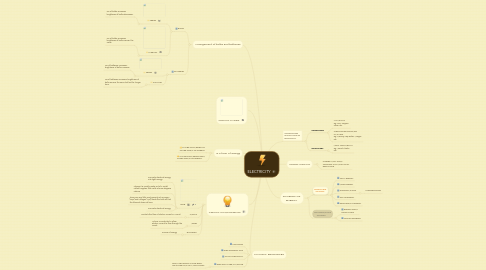
1. Arrangement of bulbs and batteries
1.1. BULBS
1.1.1. SERIES
1.1.1.1. No of bulbs increases, brightness of bulbs decreases.
1.1.2. PARELLEL
1.1.2.1. No of bulbs increases, brightness of bulbs remain the same.
1.2. BATTERIES
1.2.1. SERIES
1.2.1.1. No of batteries increases, brightness of bulb increases
1.2.2. PARALLEL
1.2.2.1. No of batteries increases, brightness of bulb remains the same but last for longer time.
2. CIRCUIT COMPONENTS
2.1. BULB
2.1.1. Converts electrical energy into light energy
2.1.2. Filament is usually made out of a metal called tungsten that melts at 3400 degrees celsius!
2.1.3. There are very little inert gases (such as argon [93%] and nitrogen [7%]) inside the bulb so that the filament does not burn
2.1.4. Converts electrical energy
2.2. SWITCH
2.2.1. Controls the flow of electric current in a cicuit
2.3. WIRES
2.3.1. Acts as a conductor to allow electric current to flow thorugh the circuit.
2.4. BATTERIES
2.4.1. Source of energy
3. NATURAL RESOURCES
3.1. LIGHTNING
3.2. ELECTROGENIC FISH
3.3. STATIC ELECTRICITY
3.4. ELECTRICAL NERVE IMPULSE
3.4.1. FROM NEUTRONS IN OUR BODY OR OTHER SIMILAR LIVING THINGS
4. Is a form of energy
4.1. CAN BE CONVERTED TO OTHER FORMS OF ENERGY
4.2. CAN BE CONVERTED FROM OTHER FORMS OF ENERGY
5. CIRCUIT CARDS
6. SOURCES OF ENERGY
6.1. RENEWABLE SOURCES
6.1.1. TIDAL ENERGY
6.1.2. WIND ENERGY
6.1.3. RUNNING WATER
6.1.3.1. HYDROELECTRIC
6.1.4. SOLAR ENERGY
6.1.5. GEOTHERMAL ENERGY
6.2. NON-RENEWABLE SOURCES
6.2.1. ENERGY FROM FOSSIL FUELS
6.2.2. NUCLEAR ENERGY
7. CONDUCTORS & INSULATOR OF ELECTRICITY
7.1. CONDUTORS
7.1.1. ALL METALS Eg. Iron, Copper, Silver, etc.
7.1.2. SUBSTANCES DISSOLVED IN WATER. Eg. Mercury, Tap water, Vinegar, etc.
7.2. INSULATORS
7.2.1. MOST NON-METALS Eg. Wood, Plastic, etc.
